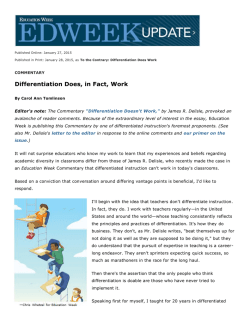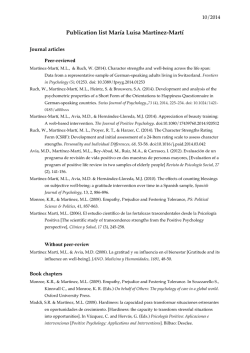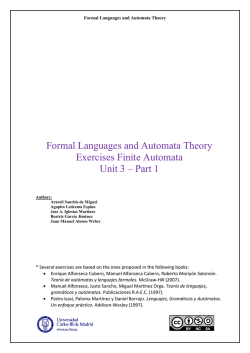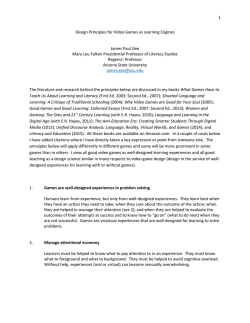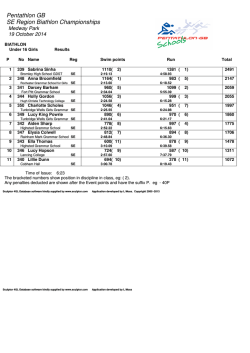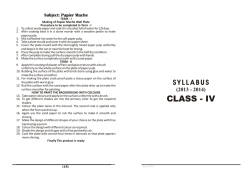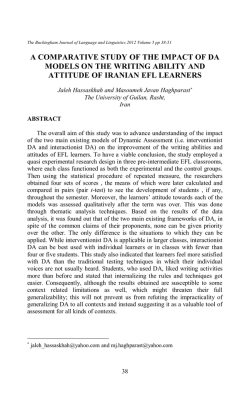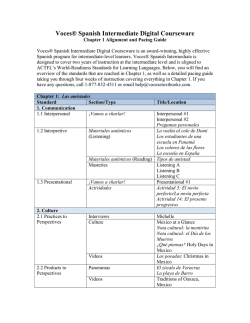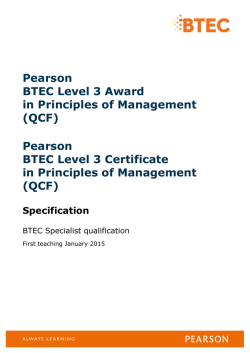
Feature Column - National Capital Language Resource Center
Feature Column Differentiating Instruction and Teaching Learning Strategies Anna Uhl Chamot, The George Washington University Students in the same language class typically differ in proficiency level and skill in language learning. When all students are given the same language task, those who feel confident that they can do the task successfully and have effective learning tools will likely be much more motivated to expend the effort to complete the task than those who believe that the task is too difficult and cannot figure out how to approach it. How can the language teacher plan appropriate instruction that meets the needs of both types of students? This article describes a combination of two approaches that can be effective: differentiating instruction and teaching language learning strategies. Differentiating instruction means that the teacher tailors tasks to students’ interests and needs, groups students with different tasks for each group, and provides varied assessments so that all students can demonstrate what they have learned. Teaching learning strategies means explaining and demonstrating different tools for working on a task, such as making inferences about new vocabulary in a text, using substitution or paraphrasing when speaking or writing, predicting logical information in an oral or written text, and many others. For names, descriptions, and teaching tips for language learning strategies, see the NCLRC’s three guides for teaching learning strategies: For K-6: The Elementary Immersion Learning Strategies Resource Guide. For 7-12: Sailing the 5Cs with Learning Strategies. For Higher Education: Developing Autonomy in Language Learners: learning Strategies Instruction in Higher Education. Learner-centered classrooms by definition provide differentiated instruction so that the needs, language levels, and degree of strategic awareness of individual learners are addressed. Differentiated instruction allows for some student choice in what they learn, how they learn it, and/or how they demonstrate their learning. When students can choose at least some of their learning goals, activities, and products, their motivation increases dramatically. One of the teaching practices recommended for differentiated instruction is teaching students how to learn, a recommendation also found in research on language learning autonomy. Teaching language learners how to learn involves developing their metacognition or understanding of their own thinking and learning processes, their ability in self-regulation, and their proficiency in using learning strategies appropriate to the language task. Using the language task described below (demonstrating comprehension of a short story in the target language) as an example, it is clear how these three cognitive and affective processes interact with and support each other. Learning strategy researchers and teachers agree that effective strategy instruction not only needs to be explicit (telling students the purpose and name of the strategy) but also must embedded in regular classroom tasks and activities. In addition, if learning strategies are taught as a path to learner autonomy, then individual learners should decide which strategies work best for them. ©2015 NCLRC@GW The Language Resource Strategy instruction should not be prescriptive; rather it should present a variety of alternatives and opportunities for students to develop their metacognitive awareness of the strategies that work for them. This focus on self-reflection is apparent in models of language learning strategy instruction that advocate as a first step developing students’ awareness of the strategies they are already using and their ability to regulate their own learning, followed by teacher modeling, practice, and selfevaluation. The following instructional guidelines are based on these several models: 1. Find out students’ prior knowledge, experiences, and reflections concerning learning strategies. Classroom discussions, surveys, checklists, questionnaires, and think-alouds can be used to discover what students already know about learning strategies. It can be helpful to ask students to complete a language learning task first, and then describe the learning strategies or techniques that they used for the task. This discussion helps students develop their awareness of the fact that they have individual ways of completing a learning task and that their classmates often have quite different techniques. In addition to helping students increase their self-reflection, this type of informal survey also provides diagnostic information to the teacher. 2. A shared vocabulary and mutually understood terminology are essential in developing students’ understanding of and control over their own learning processes. Various taxonomies of language learning strategies have been proposed, and all have features in common. For example, all acknowledge the primacy of metacognitive strategies such as planning, monitoring, and evaluation, which are central to self-regulation and can be used across different types of tasks. Other strategies may be cognitive, social, and/or affective and are often directly related to specific tasks. 3. Students need to set their own learning goals, which can include learning strategies. For example, they might respond to a brief questionnaire or checklist about what they would like to learn how to do in the new language over the next month. Having prioritized their goals, they can then decide which (if any) learning strategies might help them achieve those goals. This can be followed by having students individually complete a grid in which they identify the strategies they use most often, provide examples of how they have used each strategy, and choose three strategies they plan to use more often. 4. Teachers need to demonstrate and model learning strategies so that students can see additional possibilities for enhancing their own learning. This modeling needs to be explicit so that students can understand the cognitive processing involved in choosing and using a strategy. 5. Students can benefit from practicing the new strategy after seeing it modeled by the teacher. This practice should be with a real language task that is part of the lesson. For example, if the teacher has modeled the strategy Predicting with a reading text, students can be asked to try this strategy while reading a story. Teachers should make it clear that the purpose of this trying out is to gain some familiarity with the strategy and to determine its personal usefulness. 6. After practicing the new strategy, students can be asked to evaluate how well it worked for them. Thus, learners make the final decision of which learning strategies will become part of their personal strategic repertoires. ©2015 NCLRC@GW The Language Resource 7. Finally, the teacher can continue to model new strategies, encourage students to try them out, and ask them to evaluate their effectiveness. These suggested activities can be modified to suit student interests and needs as they journey on their path towards autonomy. Perhaps the most important concept that teachers can communicate to their students is that each of them has the capacity to take charge of their own learning by using strategies that advance them towards their individual learning goals. An Example of Differentiated and Strategy-based Instruction Señora Martínez has assigned her high school Spanish III class a short story by Gregorio López y Fuentes, Una carta a Dios. She has decided to differentiate instruction by letting students choose how they will demonstrate that they have comprehended the story, which will serve as an assessment. The choices she presents to students are: (1) Work with a group to develop a dramatization of the story for a Readers’ Theater performance; (2) Work with a partner to illustrate the story through a storyboard that includes dialogue balloons for each character and visual representations of the settings; or (3) Work individually to rewrite the story from the perspective of one of the minor characters, such as Lencho’s wife or an employee at the post office. Señora Martínez provides students with a rubric for each of these assessments to help then make their choices. She also reminds them of some of the learning strategies that can assist them. Having thoroughly assessed each of her 28 students’ levels of Spanish proficiency, skill in using learning strategies, study habits, willingness to learn, abilities in other classes, and personal interests and talents, Señora Martínez can decide which students are ready to work independently on a task and which may need help in developing the learning strategies that can help them complete the task successfully. Lucy, an eleventh grade student, considers which comprehension demonstration of Una carta a Dios to choose. In making her choice of the three comprehension tasks, Lucy asks herself several questions: Do I work best with a group, with a partner, or by myself? How well can I write in Spanish and which option best matches my writing level? These decisions involve metacognition, Lucy’s understanding of her own thinking and learning. She also asks herself questions such as: Which of the three options motivates me most? Which one am I willing to work on very hard and persevere until it is accomplished to a high standard? These are selfregulation questions involving Lucy’s ability to direct her own learning. Once she has made her choice among the comprehension tasks, Lucy then begins to deploy appropriate learning strategies: planning the task, monitoring its progress, identifying and solving problems as they arise, and evaluating (and perhaps revising) the final product. Are all language learners as thoughtful and analytic as Lucy? Certainly not – some are more like Henry, who does not yet have a clear understanding of his own learning processes or the variety of learning strategies that he can choose from to carry out a task. He really needs Señora Martínez’s help in deciding which comprehension activity to choose and how to go about organizing and executing it. Knowing her students well, Señora Martínez understands that students like Lucy can begin to work independently in choosing and carrying out the comprehension task, with help from the teacher as needed. However, it is important to meet with students like Henry to ask them to ©2015 NCLRC@GW The Language Resource consider the same kinds of questions that Lucy has already automatically asked herself. Señora Martínez asks students in Henry’s group to make a preliminary choice of activity and briefly describe what they would do to carry out the task. She identifies by name any of the suggested actions that are learning strategies and provides some additional examples of how to use these strategies. She may suggest some additional learning strategies and demonstrate them by providing descriptions of her own mental processes as she uses a strategy. In short, she provides brief, targeted learning strategy instruction to students who need it, then asks them to try out at least one of the new strategies with the comprehension task they choose. Before leaving them to work on their own, Señora Martínez asks if any of the students want to change their original choice of comprehension task, and, if so, allows them to do so. In this example, the teacher has chosen to differentiate the product or assessment of the task of reading a short story in Spanish. Another teacher might choose to differentiate the content to be read by providing a choice of three or more stories with similar themes. The stories would be at different reading levels so that students could choose to read at the level comfortable for them. Whichever way the teacher chooses to differentiate classroom tasks, language learning strategies can be taught and practiced within the context of an authentic task. ©2015 NCLRC@GW The Language Resource
© Copyright 2025
